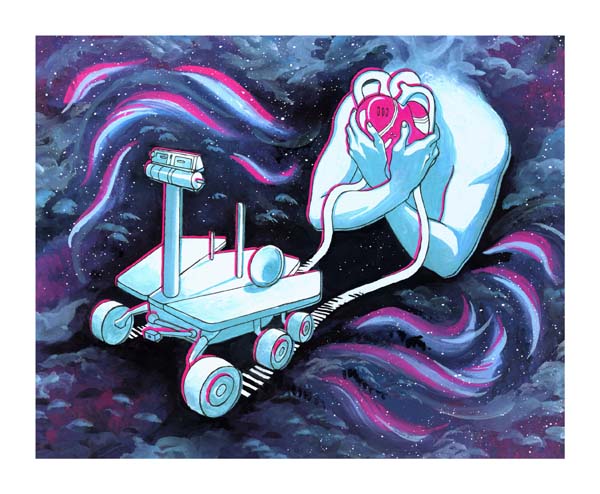An Opportunity for a New Perspective
Illustrated by Lance Bercan
Opportunity, NASA’s Mars rover, has been giving humans the chance to explore the red planet for the past fourteen years. A recent failure to communicate with Oppy—as Opportunity is commonly known—is distressing because it might mean the end of the robot’s life. This breakdown in communication does, however, offer a new possibility: instead of looking only at Mars through Oppy, we have the chance to look at ourselves through our relationship to this fascinating machine and gain a new perspective on humanity.
 Opportunity landed on Mars in January of 2004. It sent images back to earth as it traveled very slowly (about half a meter per minute when going quickly), until an important dust storm hit this summer. Since then, we have been unable to communicate with it. Many of the people working on its success have grown attached to the robot and don’t want its journey to end. NASA’s workers, though, are not the only people reluctant to see Oppy go: in the past couple of weeks, there has been an international phenomenon of space enthusiasts asking NASA not to give up on the automaton. Why is it that so many of us have become attached to a machine so incredibly far away?
Opportunity landed on Mars in January of 2004. It sent images back to earth as it traveled very slowly (about half a meter per minute when going quickly), until an important dust storm hit this summer. Since then, we have been unable to communicate with it. Many of the people working on its success have grown attached to the robot and don’t want its journey to end. NASA’s workers, though, are not the only people reluctant to see Oppy go: in the past couple of weeks, there has been an international phenomenon of space enthusiasts asking NASA not to give up on the automaton. Why is it that so many of us have become attached to a machine so incredibly far away?
In a recent episode of The Current, a CBC radio show, host David Common spoke to Mike Seibert, former lead flight director and senior driver on the Opportunity crew; Dr. Tanya Harrison, research director at Arizona State University’s Space Technology and Science Initiative; and Prof. Joelle Renstrom, a robot enthusiastic journalist for Boston’s Daily Beast. These experts offered listeners different perspectives on the situation. According to Seibert, the main reason for the high level of attachment to Oppy is the robot’s appearance. Its camera lenses look like eyes, it has an overall very symmetrical design, and its height is approximately that of an adult human. Although Opportunity’s design is not accidental, the fact that it looks so familiar to us is. Oppy appears human, and many of us have come to consider it as more than a robot because of its likeness to us. The former crew leader himself refers to Oppy as ‘‘she.’’
Seibert adds that people may be fond of Oppy because it is an underdog. Originally meant to survive on Mars for 90 sol, one sol being one Mars day and slightly longer than one Earth day, it has now been roaming our neighbouring planet for over 5000 sols. It was at its 5111th sol when the dust storm hit it. Oppy the machine is thus an engineering feat and a symbol of human achievement. Anthropomorphized, it becomes a kind of hero: one of us, leading the way in planetary exploration, surpassing all of our expectations. Renstrom claims that Oppy has become ‘‘an extension of the human race’’ as we explore space through it.
Oppy was able to survive for so long in part due to its amazing design, explains Harrison, and in part because of the weather, which provided just enough dust particles to regularly clean the machine. Now that Oppy has stopped responding, NASA has resorted to sending signals every now and then, hoping for one back. If in a month it still is not responding, NASA will wait for a spontaneous signal from Oppy without itself sending anything out. If there is a continuing lack of activity on the rover’s part, its mission may be officially considered complete. An end to Oppy’s adventure is just what so many Oppy fans fear.
Whether or not Opportunity’s sols are officially numbered, its mission break has given us the opportunity to gain a sort of meta-perspective. Though we normally gain special spatial perspective through it, we can understand ourselves better by analyzing our relation to it. People are becoming increasingly attached to machines, and through our anthropomorphizing of Oppy, we see what humans want for humanity: hope, love, and timelessness.
SOURCE:
Carr, Danielle and Ines Colabrese. ‘‘Why scientists have become attached to 'Oppy', the Mars rover stranded by a dust storm.’’ The Current, 2018. CBC Radio, [url=https://www.cbc.ca/radio/thecurrent/the-current-for-september-21-2018-1.4831874/why-scientists-have-become-attached-to-oppy-the-mars-rover-stranded-by-a-dust-storm-1.4832858]https://www.cbc.ca/radio/thecurrent/the-current-for-september-21-2018-1.4831874/why-scientists-have-become-attached-to-oppy-the-mars-rover-stranded-by-a-dust-storm-1.4832858[/url].

Comments
No comments posted yet.
You have to be registered and logged in in order to post comments!